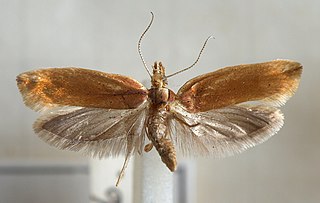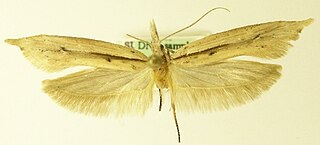Related Research Articles

Apamea crenata, known as the clouded-bordered brindle, is a moth in the family Noctuidae. It is distributed throughout the Palearctic realm. In the North it crosses the Arctic Circle, in the Mediterranean it is found only in cool locations and mountains avoiding very hot areas. In the Alps, it rises to an altitude of about 2000 metres.

Hypena rostralis, the buttoned snout, is a moth of the family Erebidae. It is found in Europe far into Scandinavia.Then through the Palearctic into Asia Minor, the Caucasus and east to Siberia. It is widespread at forest edges, forest clearings, shore areas, in gardens, park landscapes and cultivated land and rises in the mountains up to 1600 m.

Hoplodrina blanda is a moth of the family Noctuidae. It is found in the Palearctic realm.

Ypsolopha ustella, the variable ypsolopha moth, is a moth of the family Ypsolophidae. It is found in most of Europe and is also present in North America.

Mesapamea secalis, the common rustic, is a moth of the family Noctuidae. The species was first described by Carl Linnaeus in his 1758 10th edition of Systema Naturae. It is found in Europe, north-west Africa, Turkey and northern Iran.

Grammodes stolida, the geometrician, is a moth of the family Erebidae. The species was first described by Johan Christian Fabricius in 1775. It is found in Africa, southern Europe, most of Asia and Australia. It migrates to central and northern Europe as far north as England, Denmark and Finland.

Ypsolopha mucronella is a moth of the family Ypsolophidae. It is found from Europe, through Siberia to Japan and in Asia Minor.
Phyllonorycter rajella is a moth of the family Gracillariidae. It is known from all of Europe, except the Iberian Peninsula and Greece.

Ypsolopha nemorella is a moth of the family Ypsolophidae. It is found in northern and central Europe, mid-eastern China and Russia.
Ypsolopha striatella is a moth of the family Ypsolophidae. It is known from the United States, including California.
Ypsolopha delicatella is a moth of the family Ypsolophidae. It is known from the United States, including Arizona and California.
Ypsolopha cockerella is a moth of the family Ypsolophidae. It is known from the United States, including New Mexico.
Ypsolopha querciella is a moth of the family Ypsolophidae. It is known from the United States, including Arizona and Utah.
Ypsolopha vintrella is a moth of the family Ypsolophidae. It is known from the United States, including Arizona and California.

Microcolona characta is a moth in the family Elachistidae. It was described by Edward Meyrick in 1897. It is found in New Zealand and Australia, where it has been recorded from New South Wales.
Ardozyga pelogramma is a species of moth in the family Gelechiidae. It was described by Edward Meyrick in 1904. It is found in Australia, where it has been recorded from Victoria.
Antaeotricha subdulcis is a moth of the family Depressariidae. It is found in Brazil (Para) and Bolivia.
Antaeotricha trichonota is a species of moth of the family Depressariidae. It is found in Brazil and Paraguay.
Antaeotricha isochyta is a species of moth of the family Depressariidae. It is found in Guyana.
Hypercallia alexandra is a moth in the family Depressariidae. It was described by Edward Meyrick in 1909. It is found in Peru.
References
- ↑ nearctica Archived January 14, 2011, at the Wayback Machine
- ↑ Bug Guide
- ↑ mothphotographersgroup
- ↑ Description of American Moths of the Genus Cerostoma